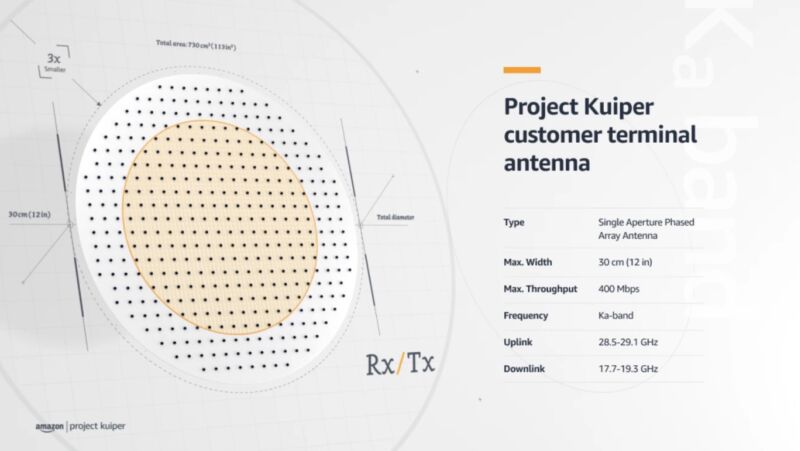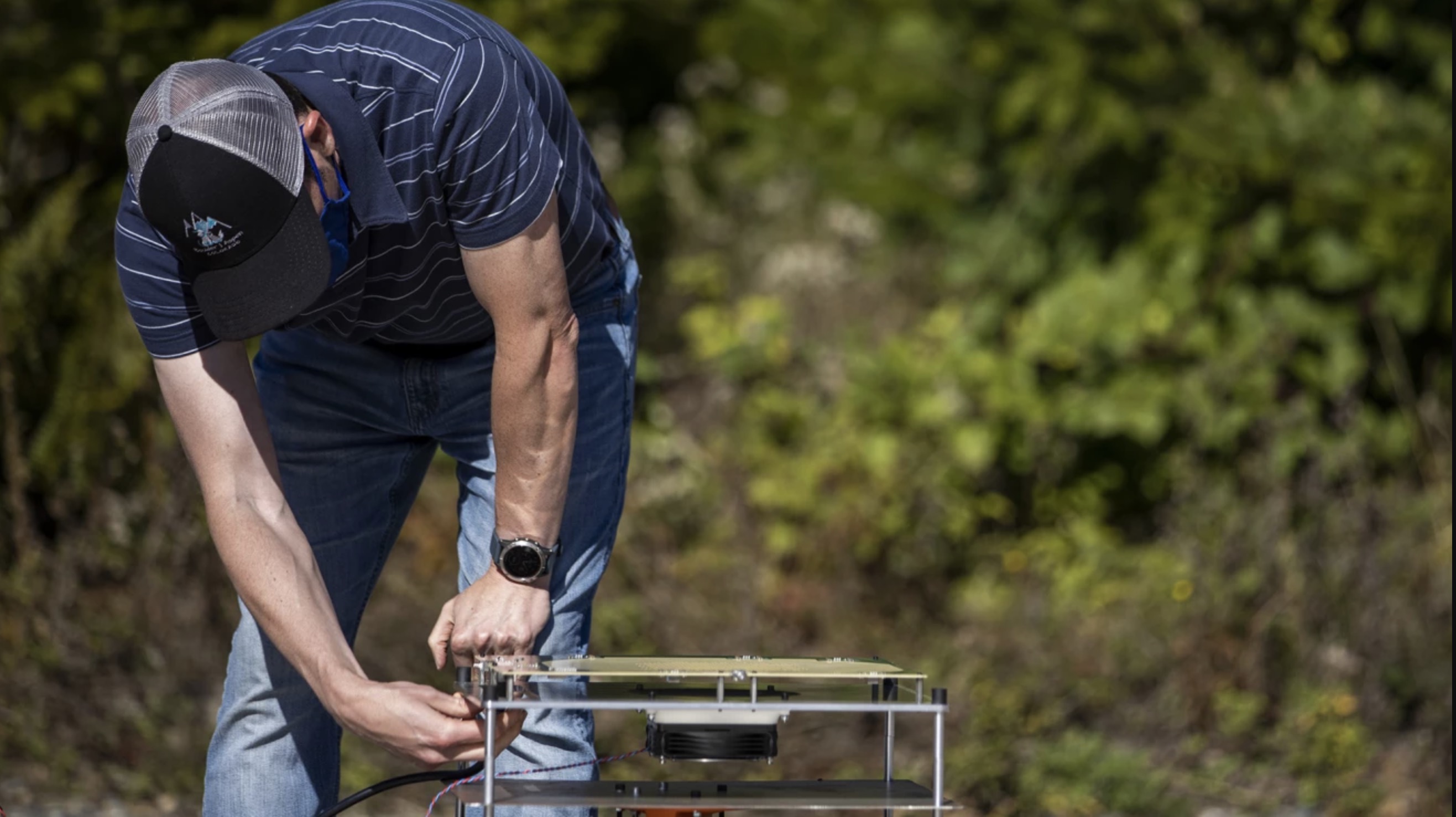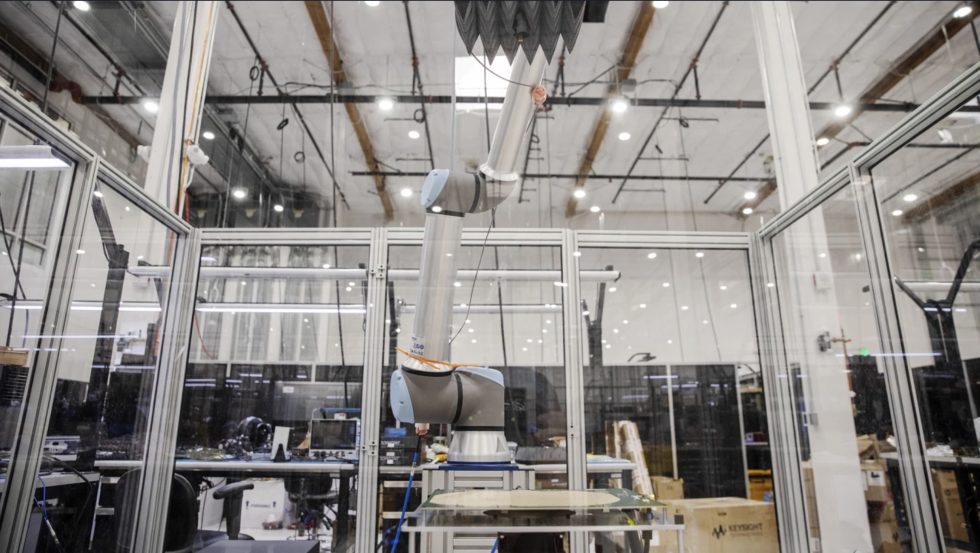

Amazon’s answer to SpaceX Starlink delivers 400Mbps in prototype phase
source link: https://arstechnica.com/information-technology/2020/12/amazons-answer-to-spacex-starlink-delivers-400mbps-in-prototype-phase/
Go to the source link to view the article. You can view the picture content, updated content and better typesetting reading experience. If the link is broken, please click the button below to view the snapshot at that time.

Project Kuiper —
Amazon’s answer to SpaceX Starlink delivers 400Mbps in prototype phase
Amazon offers peek into development of antenna for Project Kuiper user terminal.
Jon Brodkin - 12/17/2020, 11:00 PM

Amazon's competitor to SpaceX Starlink is moving through the prototype-development phase, with the company announcing yesterday that it has "completed initial development on the antenna for our low-cost customer terminal."
Amazon said its "Ka-band phased-array antenna is based on a new architecture capable of delivering high-speed, low-latency broadband in a form factor that is smaller and lighter than legacy antenna designs" and the "prototype is already delivering speeds up to 400Mbps." Performance will get better in future versions, Amazon said.
Amazon in July received Federal Communications Commission approval to launch 3,236 low-Earth orbit satellites. The company says it plans to invest over $10 billion in its satellite-broadband division, which it calls Project Kuiper.
Ka-band antennas
To reduce production costs, Amazon said it must "decrease the size, weight, and complexity" of the antenna. But this is difficult with Ka-band equipment, which needs "more physical separation between transmit and receive antennas to cover its wide frequency range," Amazon said. "For this reason, legacy Ka-band antennas place the transmit antenna and receive antenna next to one another, requiring a larger surface area and increasing production costs."
Amazon said its solution is to use "tiny antenna element structures to overlay one over the other. This has never been accomplished in the Ka-band... Our design uses a combination of digital and analog components to electronically steer Ka-band beams toward satellites passing overhead." This method let Amazon create a "single aperture phased array antenna that measures 12 inches in diameter, making it three times smaller and proportionately lighter than legacy antenna designs," the company said.
FCC filings said that Amazon's satellite plan calls for using frequencies of 17.7-18.6GHz and 18.8-20.2GHz for space-to-Earth communications, and 27.5-30.0GHz for Earth-to-space transmissions.
AdvertisementAntenna “passed all” tests
Amazon said it has tested the prototype with a geostationary satellite, though it will use low-Earth satellites when it eventually offers broadband to customers.
"Amazon engineers have tested the antenna in multiple environments to ensure it will meet customers' standards for speed and performance," the company said. "The antenna has passed all corresponding tests for speed and latency—offering maximum throughput of up to 400Mbps, and streaming 4K-quality video from a geostationary (GEO) satellite, which is stationed at an altitude approximately 50 times farther from Earth than where Project Kuiper satellites will be deployed."

The antenna is being designed and tested at Amazon's new research and development facility in Redmond, Washington. Amazon is hiring for numerous open positions at Project Kuiper.
Amazon also published an interview with Nima Mahanfar, senior manager of Project Kuiper's antenna development. He provided more detail on how Amazon combined transmit and receive antennas:
The key advancement was combining transmit and receive phased-array antennas into one aperture. This can be done in other frequency bands, but Project Kuiper plans to operate in Ka-band, which has transmit and receive frequencies that are much further apart from one another. This makes it difficult, nearly impossible in fact, to combine transmit and receive into one aperture. Phased arrays are a class of radiating system, where multiple antennas—it could be two, it could be thousands—are on the same aperture, creating a focused beam of radio waves. The distance between the antennas—or the relation between these antennas—is decided by the frequency. If the frequencies are close to each other, as with Ku-Band, you can combine the transmit and receive function into one and it works. When the frequencies are far apart, as with Ka-Band, it's much more difficult to utilize the same lattice for both. This has never been done before—until now.
Our design involves hundreds of antennas in each aperture, with receive antennas operating at 18 to 20 gigahertz (GHz) and transmit antennas operating at 28 to 30 GHz. Our breakthrough came from the realization that we could get to a single lattice by looking at each antenna element uniquely—helping reduce the size and cost of our entire terminal.
Despite that complexity, the antenna must be simple enough to be "mass producible by mainstream circuit board manufacturers, allowing us to take advantage of economies of scale and produce millions at low cost," Mahanfar said.
AdvertisementAmazon prioritizes download speeds
Amazon had to balance tradeoffs between transmit and receive capabilities, with Mahanfar saying, "We always err on the side of improving receive performance" to ensure good download speeds. "On the transmit side, if you compromise performance, you can always increase the transmitted power by a little," he added.
Going forward, Mahanfar said he thinks Amazon can make the phased-array technology more affordable "by developing new technologies and architectures that could be fundamentally different from today's approach."
He also briefly discussed the phased-array technology that Amazon is building for the satellites it will launch into space. "Solving power challenges in space is hard, and dissipating the heat from that power is even harder," he said. "There's no air to cool it. So having a low-power system that can provide many gigabytes of service to customers is key. How can we reduce the power consumption of these space-borne phased arrays? That's one of the other big challenges facing anyone deploying phased array antennas in low earth orbit."
Amazon didn't provide any updates on when Kuiper will be ready for customers. FCC rules give Amazon six years to launch and operate 50 percent of its licensed satellites, with a deadline date of July 30, 2026. Amazon would have to launch the rest of the licensed satellites by July 30, 2029. Amazon previously said it plans to offer broadband to customers "once the first 578 satellites are launched."
SpaceX Starlink satellites are already delivering broadband to beta customers, with the company promising initial speeds of 50Mbps to 150Mbps and latency from 20ms to 40ms. SpaceX said it plans significant performance enhancements by summer 2021. See our previous coverage for details and images of SpaceX's user terminal, known as "Dishy McFlatface."
Amazon is also behind OneWeb, which recently exited bankruptcy and is planning satellite launches this month and "throughout 2021 and 2022." OneWeb yesterday announced a deal in which Hughes Network Systems, a traditional satellite provider, "will produce the gateway electronics for the OneWeb system as well as the core module that will be used in every user terminal."
Promoted Comments
-
I do not think that one needs to be an Elon fanboy to note that SpaceX actually has the best part of a thousand satellites in orbit, a working system, and a rocket which has launched around 100 times. Amazon/Blue Origin has none of these things, and will be playing catch-up, and bleeding money, for the next five years. To me, the main importance of this is that we have an interesting new technology coming out of the research, and it will remind SpaceX that if they sit on their laurels, they may be in a for a real fight in the second half of the decade, which will help keep them wedded to continuous improvement.
Recommend
-
 60
60
-
 13
13
SpaceX's Starship SN8 prototype soars on epic test launch, with explosive landing By Mike Wall 13 days ago Elon Musk is thrilled: "Mars, here we come!"
-
 14
14
SpaceX's Starship SN9 prototype launches to 10 km, crashes during landing By Mike Wall 10 days ago The rocket's trip 10-km flight went smoothly until landing.
-
 4
4
SpaceX's blistering retort — Amazon asked FCC to reject Starlink plan because it can’t compete, SpaceX says SpaceX: Amazon should fix Kuiper satellite plan instead of trying to delay Starl...
-
 5
5
Amazon, fighting SpaceX’s Starlink plans, says Elon Musk’s companies don’t care about rules The pissing match before the FCC is heating up (again) ...
-
 6
6
Tesla's AI Day delivers a real Optimus prototype and more FSD updates Engineers used Tesla's automotive design and development principles to deliver a functional prototype within month...
-
 5
5
Home ...
-
 7
7
Elon Musk’s Starlink is only the beginning Satellite internet is going mainstream. So are its challenges. By
-
 7
7
V2EX › 程序员 武汉移动升级了千兆宽带,测速却只有 400Mbps?
-
 9
9
readyidc,泰国商家,提供各类主机服务,全部为KVM VPS,特色是提供1Gbps端口、不限流量,免费快照功能,支持Paypal付款。有需要的可以关注一下。
About Joyk
Aggregate valuable and interesting links.
Joyk means Joy of geeK
